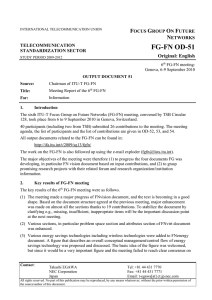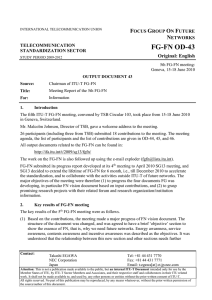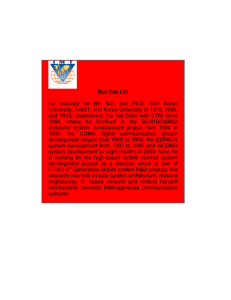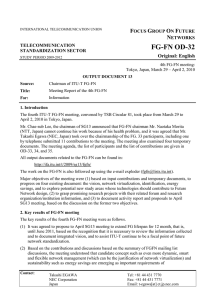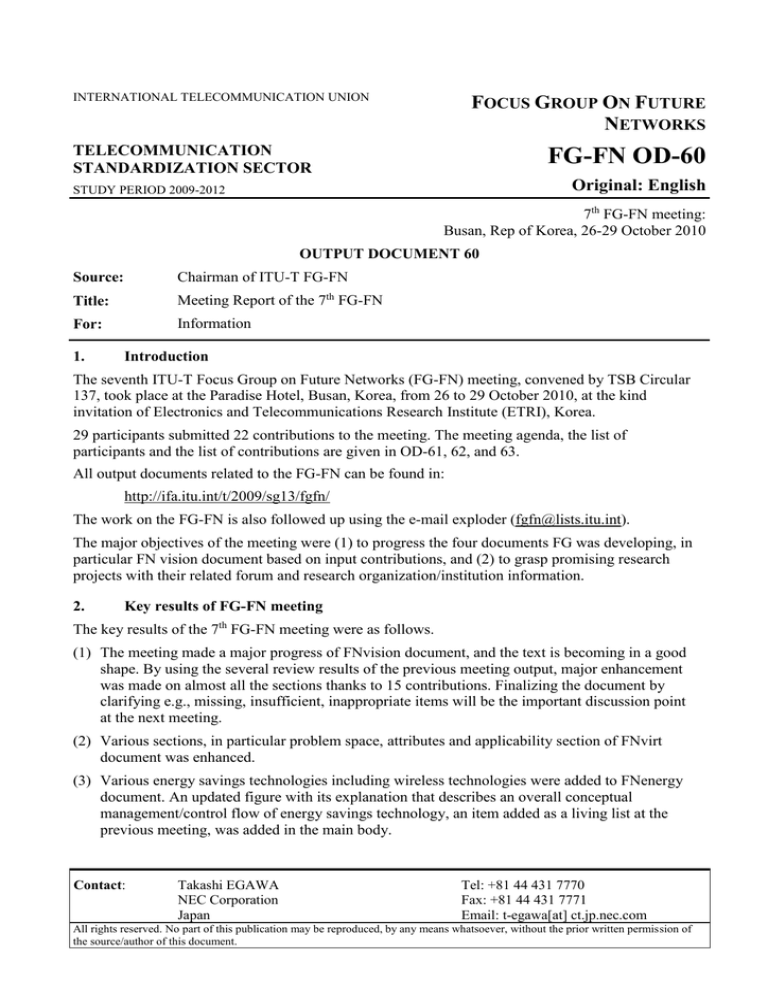
INTERNATIONAL TELECOMMUNICATION UNION
FOCUS GROUP ON FUTURE
NETWORKS
TELECOMMUNICATION
STANDARDIZATION SECTOR
FG-FN OD-60
Original: English
STUDY PERIOD 2009-2012
7th FG-FN meeting:
Busan, Rep of Korea, 26-29 October 2010
OUTPUT DOCUMENT 60
Source:
Chairman of ITU-T FG-FN
Title:
Meeting Report of the 7th FG-FN
For:
Information
1.
Introduction
The seventh ITU-T Focus Group on Future Networks (FG-FN) meeting, convened by TSB Circular
137, took place at the Paradise Hotel, Busan, Korea, from 26 to 29 October 2010, at the kind
invitation of Electronics and Telecommunications Research Institute (ETRI), Korea.
29 participants submitted 22 contributions to the meeting. The meeting agenda, the list of
participants and the list of contributions are given in OD-61, 62, and 63.
All output documents related to the FG-FN can be found in:
http://ifa.itu.int/t/2009/sg13/fgfn/
The work on the FG-FN is also followed up using the e-mail exploder (fgfn@lists.itu.int).
The major objectives of the meeting were (1) to progress the four documents FG was developing, in
particular FN vision document based on input contributions, and (2) to grasp promising research
projects with their related forum and research organization/institution information.
2.
Key results of FG-FN meeting
The key results of the 7th FG-FN meeting were as follows.
(1) The meeting made a major progress of FNvision document, and the text is becoming in a good
shape. By using the several review results of the previous meeting output, major enhancement
was made on almost all the sections thanks to 15 contributions. Finalizing the document by
clarifying e.g., missing, insufficient, inappropriate items will be the important discussion point
at the next meeting.
(2) Various sections, in particular problem space, attributes and applicability section of FNvirt
document was enhanced.
(3) Various energy savings technologies including wireless technologies were added to FNenergy
document. An updated figure with its explanation that describes an overall conceptual
management/control flow of energy savings technology, an item added as a living list at the
previous meeting, was added in the main body.
Contact:
Takashi EGAWA
NEC Corporation
Japan
Tel: +81 44 431 7770
Fax: +81 44 431 7771
Email: t-egawa[at] ct.jp.nec.com
All rights reserved. No part of this publication may be reproduced, by any means whatsoever, without the prior written permission of
the source/author of this document.
-2FGFN OD 60
(4) Basic direction of the final FG FN activities report to SG13 was presented. Finalization will be
done until end of Dec. 2010.
3.
Discussions
3.1
Vision aspects
As an experienced editor, Takashi wrote down his many questions, comments and candidate
replacement to each contribution because there were many of them. They can be found at the
document exchange area of Busan meeting. It was treated as the same kind of questions, comments
and proposed text with the verbal ones raised in the discussion. The descriptions below are the
important points in the written comments and the delta from them.
C123, NEC, Comments on FNvision document
Accepted for editing.
C122, NEC, Modification on the introduction of FNvision document
Accepted for editing with the understanding that the phrases ‘optical fibre’ and ‘silicon process’
needs better wording.
C120, Fujitsu, Proposed text regarding energy saving for section 8.1 and 9.3 of FNvision
document
On section 8.1, it was pointed out that the justification in the 1st paragraph was weak, and there is a
gap between the 1st and 2nd paragraph. It was also pointed out that the lead sentence of the 1st
paragraph in the written comment is still difficult for non-experts of life-cycle management, and
needs clarification. And it was agreed to use the term ‘power’ or ‘electric power’, not ‘energy’
though the term energy is commonly used as the synonym of electric power, because they are
different if we look not only network operation but overall environmental impact.
On section 9.3, it was pointed out that a phrase ‘unnecessary traffic’ was not very clear and ‘Satisfy
customer’s requests with minimum traffic’ was better, but since both are not satisfactory it was
agreed to find the best term in the editing session. During this discussion the importance to deepen
this discussion with experts in other SGs, if necessary, was pointed out because this seriously
affects other issues, e.g., traffic engineering and network management. It was also pointed out that
the phrase ‘reduce total power consumption’ may not be realistic because if we must start a new
service it must be started even if it increases the power consumption.
C132, Hitachi, Modification for FNvision document
A discussion was raised on which phrase is appropriate, FN, FNs, the FN, the FNs, and it was
agreed that FNs is appropriate if there is no special reason.
On section 8.3, a question was raised if we should consider the relationship between network
virtualization and cloud computing, and it was agreed not to do so because e.g., programmability is
an important issue for network virtualization to differentiate it from traditional virtual network
technologies, but not so for the resource virtualization in cloud computing. It was pointed out and
agreed to add a description that the necessity of the capability described in this section originated in
the bitter recognition of network architects that it had been impossible to predict the requirements
for future networks because the lifetime of network architecture may span more than several
decades.
C131, NTT, Proposal of revised text for Section 8 (Design Goals : Data Oriented Networking)
Accepted for editing with the understanding that
2nd sentence of the design goal is a little bit vague,
-3FGFN OD 60
the difference of viewpoint between 1st (user) and 2nd (operator) sentence of design goal is not
easy to tell at the first glance, and it is better to making it easier to read by e.g., make the 2nd
sentence 1st.
C111, Brazil,
Economic Incentives in Future Networks
On section 8.5, it was agreed that the appropriate title was ‘service universalization’. This is a term
commonly used in economics, but not well-known among engineers, so the necessity to define this
term was recognized. And it was agreed that the core idea described here should be used to enhance
section 7, objective.
C115, KT, Revised text on Economic Incentives in Section 8 of OD-55
This contribution was discussed with C-117, a contribution on the promising technology for this
design goal, section 9.7.
A question on why such design goal is necessary was raised, e.g., why unfair competition is bad
because it is difficult to define fair contribution and bankruptcy is considered a source of creative
deconstruction in many societies. It was also asked why technologies such as programmable
interface could become a solution to solve these issues. The explanation was that it was important to
sustain ecosystem, current network did not always provide an environment for that and the
contributor believes that network functions were too ossified to provide necessary functions even if
every related parties agreed. A question was raised that in the paper quoted in the contribution had
pointed out that the ossified ones had not been the network technology but the value chain. The
contributor answered that it was not rare that the introduction of new functions had been blocked
even when there was a chance for new revenue.
It was agreed to devise a new text for section 8.6 and 9.7 considering the discussion above.
C128, NTT, Proposed texts for ‘Network Management’ in section 8 ‘Design Goals’ of FN vision
document
It was pointed out that we should not mention specific technologies, e.g., common management
interface in the design goal, and it was agreed that all the design goals need to be checked. It was
also pointed out that the logic ‘FN is complicated and we need better management system’ was not
appropriate, and it was agreed to describe in a way that there are many reasons that introduces
complexity to FN and FN therefore requires more sophisticated management system. It was also
pointed out that we should mention maintenance and provisioning as well as operation. It was also
pointed out that common management interface had been a technology pursued for many years but
in vain, and a justification was necessary to raise it again as a design goal. It was also pointed out
that statistical intelligent learning is a specific technology, that it should not be mentioned in this
chapter, and that it was better to describe the objective of the technology. It was also pointed out
that the term network operator, network manager and workers co-exist and alignment necessary.
C126, ETRI,Proposed text on clause 8.8 of Draft Deliverable, “Future Networks : Design Goals
and Promising Technologies”
A question was raised if there were any difference between FN and NGN in mobility because NGN
had already started discussing seamless mobility, and it was understood that even if FN’s mobility
was under the broad umbrella of seamless mobility if the focus was different from that of NGN’s it
was ok to raise it as FN’s new design goal, but that current text had not clarified such points, and
clarification was necessary to keep this as a design goal. It was also pointed out that there is a gap
between 1st paragraph and the 2nd one.
-4FGFN OD 60
C116, ETRI, NICT, ID related updates for Deliverable on “Future Network: Design Goals and
Promising Technologies”
It was recognized that the issue discussed in this contribution has strong relationship with the
section on data-oriented network. It was therefore agreed that the phrase related to ‘contentscentric’ or ‘contents-ID’ in section 8.9 needs careful review.
It was also agreed that the section 9.4 needs to be divided into two, one is mobility part and will be
integrated with mobility, and the other is data-oriented part, and will be merged with data-oriented
sub-section in section 9 to avoid overlap.
C129, NTT, Proposed texts for ‘In-system Network Management’ in section 9 ‘Promising
Technologies’ of FN vision document
As pointed out in the discussion of C-128, it was pointed out that common interface for network
management needs careful justification.
C118, KDDI, Proposed additional text for Mobility-enhanced Distributed Networking of
FNvision document
It was agreed that the background do not have to be long, and the [short definition] part is
redundant.
C130, NTT, Proposed texts for ‘Self-optimization Networking’ in section 9 ‘Promising
Technologies’ of FN vision document
It was recognized that the technologies described in this section tend to resemble or become the
same with the ones for energy savings. It was agreed to remove the redundant part, and to focus on
the different technologies. It was also agreed that some sentences are not explained well, e.g., the
description on the all optical networks, network topology issues. It was also recognized that the title
does not align with the text.
C117, KT, Revised text on Economic Incentives in Section 9 of OD-55
See the discussion for C-115.
C124, NEC, Proposal on the modification of ‘target date’ clause of FNviosn
It was understood that the ‘smaller network’ in the 1st sentence should be component network, and
this sentence needs clarification.
Working document, UCL, untitled (proposals on FNvision document)
On FNvision document this text proposed
the change of the subtitle,
the description on the characteristics of FN, and
the description on the comparison between FN and NGN.
The meeting didn’t discuss this issue and agreed to save this material as a living list.
3.2
Virtualization aspects
C125, ETRI, Proposed text on Section 7 and Section 8 of Draft Deliverable, “Framework of
Network Virtualization” document
This contribution proposes the new text on Section 7 and Section 8 of “Framework of network
virtualization” document in order to describe the motivation and attributes of wireless virtualization.
This contribution was accepted as is.
-5FGFN OD 60
C119, KDDI, Proposed additional text on Section 8 of the framework of network virtualization
document
This contribution propose the additional text regarding the virtualized network management for
Section 8 since the management for aggregation of multiple resources was not clearly investigated.
Text was accepted as input for editor of the document.
C127, ETRI, Proposed update text on Section 9 of the framework of network virtualization
document
This contribution proposed text about federation to the framework of network virtualization
document. Accepted with an editorial change.
3.3
Energy saving aspects
C112, ETRI, Proposal on some comment of section 7 and 8 in FGFN OD-57
This contribution proposed text for 2 improvements of document. Editor of FN_energy document
is asked to adjust wording to be included in document.
C113, ETRI, Proposal on the additional energy saving technologies of wireless network in
section 7 and 8 of FGFN-OD57
Accepted with an editorial change.
C114, ETRI, Proposal on the additional energy saving technologies of wireless network in
section 7 of FGFN-OD57
Accepted with an editorial change (to include text in another section).
C121, Fujitsu, Proposal of revised additional text for candidate functions in FNenergy document
Accepted and will be included in document.
4.
Work programme
The current work items of FG-FN are as follows:
Acronym
Title
Editor
Target Date
Reference
Vision
(FNvision)
Future Network (FN): design
goals and promising
technologies
Myung-Ki Shin
(mkshin[at]etri.re.kr)
Daisuke Matsubara
(daisuke.matsubara[at]hitachi.com)
Dec. 2010
OD-64
Terminology
(FNterm)
Terminology in Future
Networks
Chae-sub Lee
(chae-sub.lee[at]ties.itu.int)
Takashi Egawa
(t-egawa[at]ct.jp.nec.com)
2010
OD-37
Network
virtualization
(FNvirt)
Framework of Network
Virtualization
SangJin Jeong
(sjjeong[at]etri.re.kr)
Hideki Otsuki
(hideki.otsuki[at]nict.go.jp)
2010
OD-65
Identification
(FNidentication)
Identifiers and Identification
processes in Future Networks
Heeyoung Jung
(hyjung[at]etri.re.kr)
Takashi Egawa
(t-egawa[at]ct.jp.nec.com)
2010
OD-39
Energy Saving
(FNenergy)
Overview of Energy Saving
of Networks
Toshihiko Kurita
(Kuri[at]labs.fujitsu.com)
2010
OD-66
-6FGFN OD 60
5.
Output documents including outgoing LS
At the 7th meeting of the FG-FN, nine output documents were produced as follows:
Doc. Number
Title
FGFN-OD-60 Meeting report
FGFN-OD-61 Meeting agenda
FGFN-OD-62 List of participants
FGFN-OD-63 List of input documents
FGFN-OD-64 Revised text of FNvision (Future Networks: design goals and promising technologies)
FGFN-OD-65 Revised text of Framework of Network Virtualization
FGFN-OD-66 Revised text of Overview of Energy Saving of Networks
FGFN-OD-67 Living list of FNvision
6.
Future planning
The plan for the future meeting and expected achievement was announced as below.
#8 meeting: 29 November – 3 December in Slovenia (final face-to-face meeting), hosted by
SIST (TSB Circular 146)
A mini-workshop to publicize FG work will be held on 1 December afternoon
Finalizing FNvision document
Progress in other FG deliverables
Development of overall FG-FN report to SG13
7.
Follow-up telephone meetings may be held after the #8 meeting to finalize FG deliverables.
Closing of meeting
The Chairman of the FG-FN expressed his sincere thanks the logistics works provided by the host
ETRI. He also expressed his thanks to all the editors and participants of the 7th FG-FN meeting for
their contributions, discussions and hard work.
_______________________

